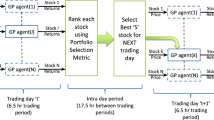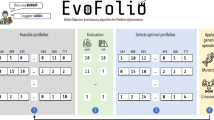Abstract
This work introduces a new algorithmic trading method based on evolutionary algorithms and portfolio theory. The limitations of traditional portfolio theory are overcome using a multi-period definition of the problem. The model allows the inclusion of dynamic restrictions like transaction costs, portfolio unbalance, and inflation. A Monte Carlo method is proposed to handle these types of restrictions. The investment strategies method is introduced to make trading decisions based on the investor’s preference and the current state of the market. Preference is determined using heuristics instead of theoretical utility functions. The method was tested using real data from the Mexican market. The method was compared against buy-and-holds and single-period portfolios for metrics like the maximum loss, expected return, risk, the Sharpe’s ratio, and others. The results indicate investment strategies perform trading with less risk than other methods. Single-period methods attained the lowest performance in the experiments due to their high transaction costs. The conclusion was investment decisions that are improved when information providing from many different sources is considered. Also, profitable decisions are the result of a careful balance between action (transaction) and inaction (buy-and-hold).
















Similar content being viewed by others
Explore related subjects
Discover the latest articles, news and stories from top researchers in related subjects.References
Aguilar-Rivera R, Valenzuela-Rendón M, Rodríguez-Ortiz JJ (2015) Genetic algorithms and Darwinian approaches in financial applications: a survey. Expert Syst Appl 42(21):7684–7697
Almgren R, Chriss N (2001) Optimal execution of portfolio transactions. J Risk 3:5–40
Çanakoğlu E, Özekici S (2009) Portfolio selection in stochastic markets with exponential utility functions. Ann Oper Res 166(1):281–297
Chen AH, Fabozzi FJ, Huang D (2012) Portfolio revision under mean-variance and mean-CVaR with transaction costs. Rev Quant Financ Account 39(4):509–526
Chen AH, Jen FC, Zionts S (1971) The optimal portfolio revision policy. J Bus 44(1):51–61
Corne DW, Knowles JD, Oates MJ (2000) The Pareto envelope-based selection algorithm for multiobjective optimization. Parallel problem solving from nature PPSN VI. Springer, Berlin
Deb K, Pratap A, Agarwal S, Meyarivan T (2002) A fast and elitist multiobjective genetic algorithm: NSGA-II. IEEE Trans Evol Comput 6(2):182–197
Elton EJ, Gruber MJ (1974) The multi-period consumption investment problem and single period analysis. Oxford Econ Pap 26(2):289–301
World Federation of Exchanges database (2015). http://www.world-exchanges.org
Finkelstein M, Whitley R (1981) Optimal strategies for repeated games. Adv Appl Probab 13(02):415–428
Gupta P, Mehlawat MK, Mittal G (2012) Asset portfolio optimization using support vector machines and real-coded genetic algorithm. J Glob Optim 53(2):297–315
Hibiki N (2006) Multi-period stochastic optimization models for dynamic asset allocation. J Bank Financ 30(2):365–390
Dow Jones Industrial Average (2015). https://finance.yahoo.com/quote/DJI
Knowles J, Corne D (1999) The Pareto archived evolution strategy: A new baseline algorithm for Pareto multiobjective optimisation. In: Proceedings of the 1999 congress on evolutionary computation, vol 1, pp 98–105
Köppen M, Yoshida K (2007) Substitute distance assignments in NSGA-II for handling many-objective optimization problems. In: Evolutionary multi-criterion optimization. Springer, Berlin, pp 727–741
Li D, Ng WL (2000) Optimal dynamic portfolio selection: multiperiod mean-variance formulation. Math Financ 10(3):387–406
Lo A, Mamaysky H, Wang J (2000) Foundations of technical analysis: computational algorithms, statistical inference, and empirical implementation. J Financ 55(4):1705–1770
Lwin K, Qu R, Kendall G (2014) A learning-guided multi-objective evolutionary algorithm for constrained portfolio optimization. Appl Soft Comput 24:757–772
Ma I, Wong T, Sankar T, Siu R (2004) Forecasting the volatility of a financial index by wavelet transform and evolutionary algorithm. IEEE Int Conf Syst Man Cybern 6:5824–5829
Markowitz HM (1968) Portfolio selection: efficient diversification of investments (vol 16). Yale University Press, New Haven
Markowitz HM, Lacey R, Plymen J, Dempster MAH, Tompkins RG (1994) The general mean-variance portfolio selection problem [and discussion]. Philos Trans Phys Sci Eng 347(1684):543–549
McDonald J (2015) Handbook of biological statistics, vol 2. Sparky House Publishing, Batimore
Ponsich A, Jaimes AL, Coello CAC (2013) A survey on multiobjective evolutionary algorithms for the solution of the portfolio optimization problem and other finance and economics applications. IEEE Trans Evol Comput 17(3):321–344
Ranković V, Drenovak M, Stojanović B, Kalinić Z, Arsovski Z (2014) The mean-value at risk static portfolio optimization using genetic algorithm. Comput Sci Inform Syst 11(1):89–109
Sharpe WF, Alexander GJ, Bailey JV (1999) Investments. Prentice Hall, Upper Saddle River
Valenzuela-Rendón M (2003) The virtual gene genetic algorithm. In: Genetic and evolutionary computation conference, Springer, Berlin, pp 1457–1468
Valenzuela-Rendón M, Uresti-Charre E (1997) A non-generational genetic algorithm for multiobjective optimization. In: Proceedings of the seventh international conference on genetic algorithms
Wang W, Hu J, Dong N (2015) A convex-risk-measure based model and genetic algorithm for portfolio selection. Math Probl Eng 2015:8. doi:10.1155/2015/451627
Yi L (2010) Multi-period portfolio selection with transaction costs. In: 2nd IEEE international conference on information and financial engineering, 2010 , pp 98–103
Zhang XL, Zhang KC (2009) Using genetic algorithm to solve a new multi-period stochastic optimization model. J Comput Appl Math 231(1):114–123
Zhou X, Yang C, Gui W (2014) Nonlinear system identification and control using state transition algorithm. Appl Math Comput 226:169–179
Acknowledgements
The authors are with the Research Group with Strategic Focus on Intelligent Systems of the National School of Engineering and Sciences at the Tecnológico de Monterrey and gratefully acknowledge its support. The first author thanks the Consejo Nacional de Ciencia y Tecnología (CONACyT) for its financial support through the PNPC program.
Author information
Authors and Affiliations
Corresponding author
Ethics declarations
Conflict of interest
The authors declare they have no conflict of interest.
Rights and permissions
About this article
Cite this article
Aguilar-Rivera, A., Valenzuela-Rendón, M. A new multi-period investment strategies method based on evolutionary algorithms. Neural Comput & Applic 31, 923–937 (2019). https://doi.org/10.1007/s00521-017-3121-6
Received:
Accepted:
Published:
Issue Date:
DOI: https://doi.org/10.1007/s00521-017-3121-6




